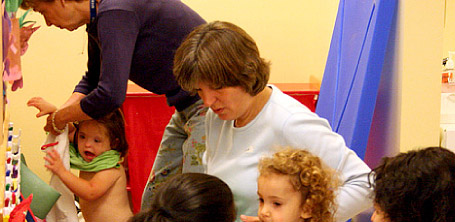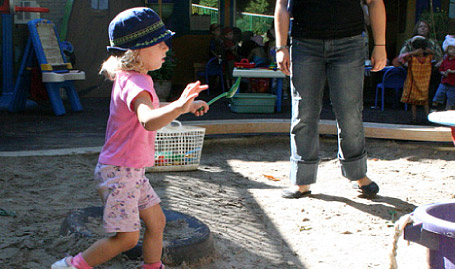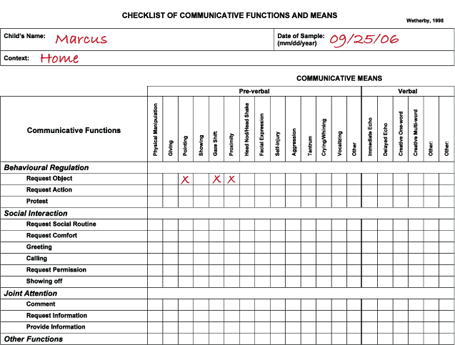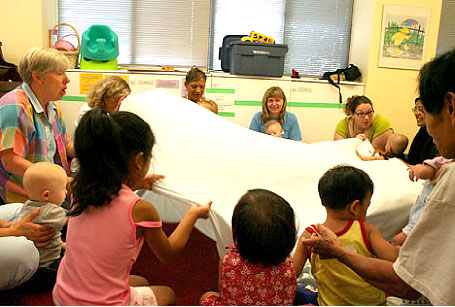
Chung Lee is a five-year old girl with Down Syndrome. When it’s time for all the children to get ready for outdoor play, Chung Lee often begins to tantrum as she tries to put on her jacket. She throws her things to the floor and screams. The teacher calms Chung Lee down and then helps her put the jacket on. The teacher notices that this is happening every day and does not have enough time to help the other children.
Does this story about Chung Lee getting dressed sound familiar to you – perhaps you have a child like Chung Lee in your classroom?
If so, then you’ve actually taken the first step of identifying a problem behaviour that may be putting a child at risk. In this case, Chung Lee’s problem behaviour is also interfering with her social, emotional and intellectual development.
Deciding what to do next may be difficult. Here’s the 3-step approach we followed in Understanding and Changing Behaviour.
Step 1: Decide Where to Start
We’ve identified a problem behaviour. Let’s take a moment to describe what we see or hear. Describing the behaviour will help us to be consistent when gathering information a bit later.
Chung Lee throws her jacket and/or hat to the floor. She then screams very loudly.
We’ll also want to talk with Chung Lee’s parents to find out if she has any difficulty getting dressed at home or displays this behaviour with other activities. Then we’ll spend some more time observing Chung Lee at the centre.
Team teachers agree to record their observations using the ABC Functional Assessment Card for the next five days. We’ll chart at least six times before reviewing the information. We will also use the Motivation Assessment Scale (MAS) by Durand and Crimmins to learn more about the possible functions of the behaviour.
Since the behaviour usually happens when getting dressed, we are also going to look at how Chung Lee gets undressed and see if there are any concerns around this routine.
Now we’ll move onto the next step.
Step 2: Gather and Analyze
After speaking with Chung Lee’s parents, we learned that she does not demonstrate any of the problem behaviours at home. Chung Lee’s parents reported that they help her put on the clothing, pull up the zippers, or undo the buttons on her pants, sweaters and jackets.
We believe that the expectations for “getting dressed” are different at home than at child care. Chung Lee receives full assistance from her parents to get dressed but is encouraged to first try on her own at child care.
We completed the Motivation Assessment Scale and recorded our observations throughout the week using the ABC Functional Assessment Cards. After analyzing all the information we collected, here’s what we noticed about Chung Lee’s behaviour:
- The behaviour happens twice a day, while getting ready to go out to the playground – in the morning and afternoon.
- Chung Lee gets her jacket from the cubby, holds it in one hand and tries to slide the other hand into the arm opening. Her hand misses the opening. Not getting her hand in the opening appears to trigger the problem behaviour.
- We also noticed that when Chung Lee’s parents come to pick her up, they help her put on the jacket and hat (e.g., hold the jacket, put her arms through the sleeves, pull up the zipper, and pull the hat down onto her head).
- Teachers respond to Chung Lee’s behaviour by telling her to pick up the jacket or asking her to “try” again. The screaming gets much louder and teachers quickly go to put the jacket and hat on for her.
- After being helped Chung Lee stops screaming.
- We also noticed that the cubby area is a bit crowded during this routine. Chung Lee is sometimes pushed or bumped by a child next to her. This also happened before we see the problem behaviour.
We also observed Chung Lee when she takes off her jacket and hat.
- There were no issues with undressing but Chung Lee does have a very interesting way of removing her jacket. She locates the zipper and pulls it down almost half way. Then she wriggles out of her jacket and tosses it into her cubby or leaves it on the floor.
- The hat was pulled off very quickly and easily as Chung Lee grabbed it from the top.
According to our analysis of the information we gathered, there are two possible functions or reasons for Chung Lee’s behaviour: escaping the activity because it is too difficult, and/or obtain attention from a teacher to get help. We are going to focus on the function of escaping the activity when we plan for change.
Step 3: Plan for Change
Planning for change involves making the behaviour irrelevant, inefficient and finally ineffective.
Making the Behaviour Irrelevant
We can make the behaviour irrelevant by preventing or controlling the things in the environment that happen before the behaviour.
Let’s take a look at some ways to prevent the behaviour from happening by changing the environment, adapting routines and using visuals.
Environment
We’re going to place a plastic mirror on the wall in the cubby area to help Chung Lee see what she is doing while trying to get dressed. The physical space is a bit small for all the children to get dressed at once so we are going to adapt this routine (see below).
Routines
We’ll adapt the routine by dividing the children into two smaller groups. In Chung Lee’s group we will include children who can dress independently and can model appropriate behaviour.
Activity
We will discuss the getting dressed routine at circle time by reading books about this self-help task. We can also add doll-sized jackets and hats to the dramatic area so that Chung Lee can practice this skill through play.
Using Visuals
We will create a mini-schedule with photos of each step involved in “putting on a jacket”. We will post one near Chung Lee’s cubby and another one on or above the mirror. This visual support will be very useful for teaching Chung Lee this self-help skill.
Making the Behaviour Inefficient
To make behaviour inefficient, we might choose to teach specific adaptive, educational and social behaviours. By teaching these types of behaviours, we eliminate the need for the problem behaviour.
At other times, we may teach an alternative behaviour. An alternative behaviour serves the same function as the behaviour being replaced but is seen to be more appropriate by other children, adults and the general public. To be successful, it requires equal or less physical effort and complexity but results in the same type of pay-off for the child.
In this case, we’re going to teach Chung Lee how on put on her jacket – step by step. For specific details on the strategies and other teaching techniques we used to teach Chung Lee to “put on a jacket” visit our “Teaching New Skills” section.
Making the Behaviour Ineffective
The last step is to make problem behaviour ineffective, meaning that it no longer works for the child. Keep in mind that the behaviour may not change right away. It is very common for problem behaviour to increase before it decreases when implementing changes. The key is to be consistent with the plan.
Everyone on the teaching team will be sure to ignore the throwing and screaming behaviour. We’ll praise Chung Lee for being quiet in the cubby area and reward her for completing the steps to putting on her jacket.
It will also be important to make the behaviour ineffective in all the places a child finds herself. Changing a problem behaviour that continues to be rewarded in other settings is confusing to the child and frustrating for everyone. In this case, we will talk with Chung Lee’s parents and discuss how they too can help Chung Lee learn to put her jacket on independently, at home, by using the same strategies we will use at child care. Our partnership with parents is the key to success.
If the problem behaviour persists then we will have to re-assess but it is important for us to give our plan time to work. Be patient! Some behaviours can take a couple of weeks to change.



